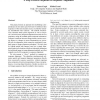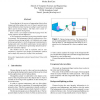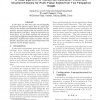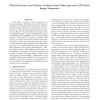74
Voted
CVPR
2000
IEEE
15 years 5 months ago
2000
IEEE
In this paper we address the problem of matching two images with two different resolutions: a high-resolution image and a low-resolution one. On the premise that changes in resolu...
60
Voted
CVPR
2000
IEEE
15 years 5 months ago
2000
IEEE
Many communicative behaviors in the animal kingdom consist of performing and recognizing specialized patterns of oscillatory motion. Here we present an approach to the representat...
105
Voted
CVPR
2000
IEEE
15 years 5 months ago
2000
IEEE
This paper presents an approach for establishing correspondencesin time and in space between two differentvideo sequences of the same dynamic scene, recorded by stationary uncalib...
103
click to vote
CVPR
2000
IEEE
15 years 5 months ago
2000
IEEE
We present a framework for tracking rigid objects based on an adaptive Bayesian recognition technique that incorporates dependencies between object features. At each frame we fin...
87
Voted
CVPR
2000
IEEE
15 years 5 months ago
2000
IEEE
We have assembled a standalone, movable system that can capture long sequences of omnidirectional images (up to 1,500 images at 6.7 Hz and a resolution of 1140 × 1030). The goal ...
88
Voted
CVPR
2000
IEEE
15 years 5 months ago
2000
IEEE
Croma keying is the process of segmenting objects from images and video using color cues. A blue (or green) screen placed behind an object during recording is used in special effe...
108
click to vote
CVPR
2000
IEEE
16 years 2 months ago
2000
IEEE
In this paper we show that given two homography matrices for two planes in space, there is a linear algorithm for the rotation and translation between the two cameras, the focal l...
158
click to vote
CVPR
2000
IEEE
16 years 2 months ago
2000
IEEE
Scene ow is the 3D motion eld of points in the world. Given N (N > 1) image sequences gather ed with a N-eye stereo camera or N calibrated cameras, we present a novel system wh...
111
Voted
CVPR
2000
IEEE
16 years 2 months ago
2000
IEEE
In this paper we present a novel approach to estimate and analyze 3D uid structure and motion of clouds from multi-spectrum 2D cloud image sequences. Accurate cloud-top structure ...
100
Voted
CVPR
2000
IEEE
16 years 2 months ago
2000
IEEE
Many problems in vision can be formulated as Bayesian inference. It is important to determine the accuracy of these inferences and how they depend on the problem domain. In recent...




